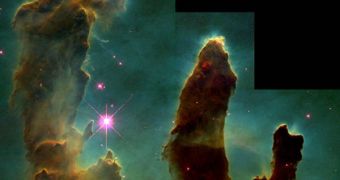Astronomers know that planets and stars form from collapsing clouds of cosmic gas, but the exact factors that trigger this formation have thus far remained elusive. Now, a combined study from two of NASA's Great Observatory is attempting to provide a possible answer to this puzzle. Readings from Chandra and Spitzer have imaged a peculiar stellar nursery within the Milky Way, which seems to be one of the most appropriate places to investigate. Further research could finally determine exactly what it is that drives stellar and planetary formation.
According to some theories, responsible for the triggering of a stellar nursery could be the original gas clouds' own gravity. As the gas chills from its initially high temperatures, gravity starts take over as the dominant force inside it, and collapses it unto itself, thus setting the basis for star formation. Other theories have it that outside factors, such as a supernova shock wave, or radiations from massive stars may be responsible for the initiation of the phenomena.
“Astronomers have generally believed that it's somewhat rare for stars and planets to be triggered into formation by radiation from massive stars. Our new result shows this belief is likely to be wrong,” says the lead author of the new study, Pennsylvania State University (Penn State) expert Konstantin Getman. A few older studies have also hinted at the fact that stellar nurseries may in fact operate on a combination of the two types of factors.
In the observations that the Chandra X-ray Observatory and the Spitzer Space Telescope made of a region of our galaxy known as Cepheus B, experts noticed the signs of an active stellar nursery. The formation is located some 2,400 light years from the Earth, and features stars that are both several million years old and less then a million years old. This means that the stellar nursery is still active, and that it constitutes one of the most promising places to study and test stellar formation theories.
“It seems like this nearby cloud has already made most of its stars and its fertility will soon wane. It's clear that we can learn a lot about stellar nurseries by combining data from these two Great Observatories,” says Eric Feigelson, also from Penn State, and a co-author of the new study. “We essentially see a wave of star and planet formation that is rippling through this cloud. Outside the cloud, the stars probably have newly born planets while inside the cloud the planets are still gestating.”

 14 DAY TRIAL //
14 DAY TRIAL //